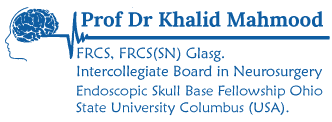Deep Brain Stimulation Surgery (DBS) in Lahore, Pakistan
Prof Dr. Khalid Mahmood, the most experienced British trained neurosurgeon pioneered DBS surgery for Parkinsons disease in Pakistan in Nov 2014 at Lahore General Hospital. He also to his credit has the largest number of DBS surgeries performed in Pakistan.
Prof Mahmood defines Deep Brain Stimulation (DBS) as a neurosurgical procedure involving the implantation of a medical device called a neurostimulator also known as brain pacemaker.Its works is to send electrical impulses, through implanted electrodes, to specific targets in the brain for treatment of the movement and neuropsychiatric disorders.
Deep Brain Stimulation (DBS) in Lahore Is Done To Recover Movement Disorders
DBS is a relatively complex therapy that requires regular neurological follow-up and battery changes every 4-5 years.The time to consider DBS surgery is when quality of life is no longer acceptable on optimal medical therapy. The major risks are 1% risk of stroke causing a permanent deficit, due to bleeding in the brain, and a 2-5% chance of infection.
What is Deep Brain Stimulation Surgery (DBS)?
Deep brain stimulation (DBS) is a surgical treatment relating the joining of a medical device called a brain pacemaker, which sends electrical impulses to exact parts of the brain. DBS in select brain regions has provided extraordinary therapeutic benefits for otherwise treatment-resistant movement and affecting disorders such as Parkinson’s disease, chronic pain, dystonia and tremor. Even with the long history of DBS, its fundamental principles and mechanisms are still not clear. DBS straight changes brain movement in a controlled manner; its effects are reversible (unlike those of lesioning techniques) and are one of only a few neurosurgical methods that allow blinded studies.
Components & Placement
The deep brain stimulation system consists of three components:
- The implanted pulse generator (IPG)
- The lead
- Extension
The IPG is a battery-powered neuro-stimulator covered in a titanium housing, which sends electrical pulses to the brain that interferes with neural activity at the target site.
The lead is a coiled wire insulated in polyurethane with four platinum-iridium electrodes and is placed in one or two different cores of the brain. The lead is connected to the IPG by an extension, an insulated wire that runs below the skin, from the head, down the side of the neck, behind the ear to the IPG, which is placed subcutaneously below the clavicle or, in some cases, the abdomen. The IPG can be calibrated by a neurologist, nurse, or trained technician to optimize symptom suppression and control side-effects.
DBS leads are placed in the brain according to the type of symptoms to be treated. For those who are not patient of Parkinson essential tremor, the lead is placed in the ventrointermediate nucleus of the thalamus; for dystonia and symptoms associated with Parkinson’s disease, the lead may be placed in either the globus pallidus internus or the subthalamic nucleus; for OCD and depression to the nucleus accumbens; for incessant pain to the posterior thalamic region or periaqueductal gray; for Parkinson plus patients to two nuclei simultaneously, subthalamic nucleus and tegmental nucleus of pons, with the use of two pulse generators; and for epilepsy treatment to the anterior thalamic nucleus.
All three components are surgically implanted inside the body. Lead implantation may take place under local anesthesia or with the patient under general anesthesia such as for dystonia.
Essential Tremor
DBS is a highly effective therapy for patients with essential tremor, often resulting in an 80% decrease in tremor that lasts for several years. Patients with a tremor secondary to stroke, traumatic brain injury or
multiple sclerosis are less likely to benefit from DBS, but may still be surgical candidates if expectations are realistic.
Parkinson Disease
DBS surgery offers important symptomatic relief in patients with moderate disability from Parkinson’s disease who still retain some benefit from anti-parkinsonian medications and who are cognitively intact.
Who should get Deep Brain Stimulation (DBS)?
It is not necessary to suffer for years after diagnosis with a movement disorder, trying every known combination of medicine, before DBS can be considered. Anyone who would get significant benefit from the treatment and can undergo the operation with minimal risk. DBS is a surgical option that is known to improve quality of life for movement disorder patients.
Care Should Be Taken After Deep Brain Stimulation Surgery (DBS)
The procedure of Deep Brain Stimulation Surgery (DBS) in Lahore, Pakistan is long, and the patient will need a short hospital stay later to improve from the surgery. Following the procedure itself, the patient meets numerous times with the neurologist to regulate the stimulation. The pulse generator is programmable, and can be fine-tuned to the patient’s specific requirements. This can deliver a higher degree of indication relief than lesioning surgeries, but needs frequent visits to the neurologist. Pulse generator batteries must be replaced every 3 to 5 years. This is done with a small incision as an outpatient procedure. Since the generator is in the chest area, no extra brain surgery is essential.
Our specialists take good care for Deep Brain Stimulation Surgery (DBS) in Lahore, Pakistan. The patient’s medications are adjusted afterward surgery, with a decrease in levodopa likely in most patients, who accept DBS of the subthalamic nucleus.



